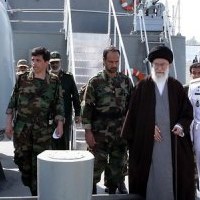![]()
Mon, Nov 14, 2011 | By Jared Feldschreiber
Binding and Non-Binding Agreements Pertaining to the Arab-Israeli Conflict
International law has played a central role in attempting to solve the Arab-Israel conflict but their respective passions, cultural differences, and distinct narratives of the two sides have often taken precedence over it.
The conflicting personal narratives and ancestral hostilities with the Israel-Arab conflict override the existing agreements and various treaties that were proposed by intergovernmental organizations, like the United Nations. It remains to the individuals of the countries themselves to generate peaceful reconciliation to the conflict. As a result, the merits and power of international law has often fallen by the way side. While Israel today is an open and pluralistic society, Palestinian society remains fragmented, and as a result their national aspirations of a Palestinian State remains unfulfilled. The Palestinian narrative remains steadfast that the early 20th century “Zionist Project” was a result of imperialism, which vanquished their aspirations. This essay will prove that international law has helped to provide to, at the very least, a worthwhile framework for a peaceful solution to this festering conflict, but it remains unlikely that the participants involved will be able to temper their deeply-rooted passions and ideologies, to achieve negotiations.
The sovereign claims to Jewish and Arab territory remains the main thrust of division between these two cultures. For over three-thousand years, the Jewish people were defined by their identity, their religion (Judaism), their language (Hebrew), all the while adhering to their particular legal code. They were shaped by legal tenets of the Bible, and an understanding that for centuries they were a people in exile, particularly until the Roman Empire, which banished them, and had ultimately named this territory Palestine. In late 19th and early 20th century, there existed a growing Arab and Jewish presence in Palestine. The Zionists sought to rebuild the ancient ancestral Jewish homeland. The Arabs and Jews clashed as a result; riots ensued between these new immigrants and Palestinian Arabs who were living there. After the Ottomans ceded the territory at the end of World War I, the allies did not annex the territories but agreed to administer them according to a Mandate negotiated with the League of Nations. “Palestinian” identity would not be forged until the 1948 War, but many Palestinian Arabs lived there years earlier.
The territorial concerns of the Israeli-Arab conflict traces back to the end of the Ottoman Empire. As stated, the Palestinian Arabs instigated riots against new Jewish immigrants. This was coupled with the emergence of the Zionists’ attempt to call for a voluntary or compulsory transfer of the Arab population. While under the British Mandate, there was a growing call for a Jewish state within Palestine. The Balfour Declaration became an informal recognition, and by the 1922 League of Nations Mandate for Palestine became valid in accordance with international law. This was insofar as it became binding by the United Nations after the Balfour Declaration, which stated in a letter that some in the British government had been “in favor of a Jewish national home in Palestine.” There was no legal language behind the Balfour Declaration, but the 1922 League of Nations Mandate for Palestine, actually set in motion legal, binding and ratified boundaries to be set up for the Jewish Homeland within Palestine. It set up some boundaries for a Jewish national home, how ever ambiguous and not clearly defined as what would be created twenty-five years later. Particular articles specifically made mention of territory to be allocated to the Jews, separate from the Arabs, which would be in accordance under international law.
The League of Nations Mandate of Palestine in 1922 continues to have relevance today, as the points concerning “what entails a Jewish State” persists, even during its period under British auspices. Legal discussions about settlements, Jerusalem, refugees, and permanent boundaries, were not discussed then but this was still a ratified and binding commitment with far-reaching consequences later on. The British Mandate for Palestine of 1922 was the first legally binding commitment to help promote an eventual Jewish State. Future resolutions, like the Resolution 181, (Partition Plan of 1947) became a recommendation by the UN, and would not have existed had the League of Nations Mandate been put it into effect twenty-five years prior. The League of Nations Mandate stipulated that “while ensuring that the rights and position of other sections of the population are not prejudiced, the British Mandatory Authorities shall facilitate Jewish immigration under suitable conditions.” During this time, the Arabs already had twenty independent states, while objecting to a Jewish homeland in the Middle East.
Concerning territorial concerns, Resolution 181 was the 1947 UN Partition Plan for Palestine. The British relinquished their rights to the mandate, and subsequently in November 1947, by a two thirds majority, recommended the partition of Western Palestine into three entities; a Jewish state, an Arab state and a separate international entity of Jerusalem. The Jewish leaders accepted the plan, despite only being granted less than 20% of the area of mandatory Palestine. It was rejected outright by all the Arab states in the UN, and by the Arabs living in Palestine.
The Arabs declared war against Israel on May 15, 1948, one day after its declared independence. Israel’s ultimate victory against 6 Arab armies set in motion a host of international law concerns. Up until 1979, when Israel made a historical agreement with Egypt, none of the Arab states agreed upon recognized or accepted permanent borders with the Jewish state. The 1949 Armistice Agreement, signed after the 1948 War, delimited the Armistice Demarcation Lines, called the “Green Line.” Arab states insisted that the “Green Line” should not be given as status to a permanent border. Israel’s peace treaties with Egypt in 1979 and then Jordan in 1994 changed the boundary-lines yet again. Boundaries would remain the main line of contention between Israel and her neighboring Arab states.
As a result of the 1948 War, the area of East Jerusalem came under Jordanian rule. The “Green Line” served as the demarcation between Israel and what was known as the “West Bank of Jordan.” During Jordanian sovereignty of the West Bank, the Arabs had never called for the existence of a Palestinian state. The Palestinian narrative was also shaped by the 6-day War. As a result, the Palestinian Arabs were largely seen by outsiders as people who ought to be entitled to their rights of self-determination. When Israel defeated three Arab armies (Jordan, Syria and Egypt), and retook Jerusalem and captured the West Bank in the 1967 Six-Day War, the Palestinians rights of self-determination was addressed. As a result of the war, the UN Security Council adopted UN Resolution 242, which was a non-binding resolution, but ultimately became accepted by all parties in the conflict.
The particularly vaguely worded language of UN Resolution 242 was cited under Chapter 6 of the UN Charter, dealing with disputes and settlements. Israel’s victory in the 6-Day War radically re-shaped the Middle East map. In its sweeping victory, Israel took control reunified Jerusalem, taking East Jerusalem, areas of the West Bank, Sinai and Gaza Strip from Egypt, and the Golan Heights from Syria. The Resolution was drafted on November 22, 1967 — five months after the war. In order to understand the boundary concerns of the Resolution 242, one needs to understand the 1949 Armistice Lines Agreements. Israel’s occupation of these territories was permissible, and legal, under international law. The 1949 Armistice Lines was a military agreement, and not a legally binding international treaty. The Arab states and Israel did regard it as a binding treaty, albeit a temporary one.
The 1949 Armistice Agreement was merely a cessation of violence that set up the “Green Line” but did not obligate the Arab States or Israel to any future binding commitments. Also Resolution 242 contains the controversial legal language that is open to interpretation: the distinction between “territories,” and “the territories,” as to where Israel must withdraw became impossible to define, as the original document was in English, but since it was also translated in French, lit lead legal confusion as to its proper wording. Also, even though this is the document Palestinians refer today to legitimize their claims to “Palestine,” the Palestinians (as an entity) are also never mentioned in the resolution. Also, the West Bank was never been annexed by Israel, so the Jewish state has suggested they would use this territory as a potential “bargaining chip” for future negotiations.
Today, certain areas in the West Bank are under Israel’s auspices, while other parts are under the supervision of the Palestinian Authority. For their areas controlled in the West Bank, Israel must follow specific international law in how to administer occupied territory. While many in the world community routinely condemn Israel for the illegality of Occupied Palestine, from an international law standpoint, this is a myth: occupation is legal in times of armed conflict, and these specific boundaries for a recognized Palestinian state were never clearly defined by two recognized states. The Security Council themselves never called the occupation as illegal. The legality of the continued expansion of Israeli settlements in the West Bank is perceived as troublesome, but to be sure, the parameters and boundaries of a Palestinian state remain undefined. When a binding commitment is reached between two sides, only then will Israel be obligated to dismantle these settlements, much like it was obliged to do with settlements in Sinai returned to Egypt during the Egypt-Israel Camp David Accords of 1979.
The Palestinians often cite Resolution 194 as the legal basis to which they should be granted a full “right of return” to their ‘ancestral homeland’ of Palestine. About 700,000 Arabs were estimated to flee from Palestine in 1948; to the Palestinians, they were purged out of their land by the Zionists. The Jewish narrative remains that the growing Palestinian refugee problem largely due by an Arab unwillingness to accept the existence of a Jewish state in Palestine. The Zionist narrative is that some of these refugees fled due to a combination of evacuation orders from the Arab side, and their own legitimate fears of expulsion. Neighboring Arab states also refused to absorb them, which exacerbated this crisis. Resolution 194 states that “refugees wishing to return to their homes and live at peace with their neighbors should be permitted to do so at the earliest practicable date.” This is exactly what Israelis routinely point to as flawed, because they are confident these “Palestinian Arabs” will never choose to “live peaceably with their neighbors,” a predominant Jewish State, rather to overwhelm them with population growth.
To the Zionists, the 1948 War was about its existential survival. Palestinian Arab refugees fled at the behest of Arab armies who were assured that they would be protected. Some of the Palestinian Arabs were living in places throughout Palestine, like Safed and in Haifa and Acre. Palestinian Arabs today feel as though their descendents ought to be given a chance to return there under Resolution 194. Clearly, Israel will never recognize such a claim, mostly due to its own legitimate security concerns, but also under international law, this resolution does not grant them this kind of ‘right of return.’ The Palestinians “right of return” was not cited in any declared, official agreements, and even not in the 1993 Declaration of Principles, where it was used opaquely, suggesting that “a just and adequate solution to the refugee crisis should be handled at the right time.”
Israel has contended that Resolution 194 maintains gaping holes, to be tweaked with future talks, but a uniform “right of return” to places where Palestinian Arabs had fled during war, remains unacceptable. The Palestinians, meanwhile, remain adamant that these refugees in war, and should be compensated for, and at the very least, also allowed their right to return to their city (and country) of origin. The rights of self-determination, as envisioned by the UN Charter, remains limited, and apply to those, but not to those in an existing state. Under international law, the Palestinians are currently not part of an existing state. Another claim they make is based on the International Covenant on Civil and Political Rights (ICCPR), stating that “no one shall be deprived of the right of return to his own country.” But this begs the question: “to who’s country?” Palestinian refugees are not, and were never nationals to the state of Israel. A good majority of the refugees moved from homes in what is present day Israel to other territories, so thus if Palestine was their country they have remained in their country. In a twist, the Jewish narrative also points to Jews living in Arab countries as refugees who were never compensated for, and who were forced to leave their own property behind, and with some cases, had special laws that deprived them rights to their own property.
It remains to the individuals of the countries themselves to generate peaceful reconciliation to the festering Israeli-Arab conflict. For instance, Egyptian President Anwar Sadat took the unprecedented and bold step to recognize Israel’s right of existence, just a few years after the 1973 War, to sign a peace treaty with Israel. He was rewarded by Western backing and for a permanent cessation of violence between the two counties. Israel’s peace treaty with Jordan has also been beneficial for both countries, in economic and security concerns.
The future of a Palestinian state remains open-ended because it remains to see whether the Palestinians or the Arab world in general, will recognize a Jewish state in the Middle East. It is also uncertain whether Israel will promote a sincere recognition of the rights and sovereignty to Palestinian national aspirations. In international law and agreements, actors on the world stage must demonstrate good faith in negotiations. International law may help navigate the road toward peace, but the states, and leaders themselves, must act with vision, and look beyond their own deeply-rooted ancestral histories. International law has played a part in solving the Arab Israeli conflict, but as these specific problems persist, there is little hope believing long-standing ideologies will shift anytime soon.
Jared Feldschreiber is a journalist and writer. His articles mostly deal with international affairs, and had spent over a year working in the Jerusalem Bureau with Fox News. Many of his articles have published with different newspapers and journals concerning Israel and American human interest stories. He has his Masters Degree from Tel Aviv University in Security and Diplomacy studies, all the while has contacts with media centers throughout Israel and in America. His articles have appeared with Fox News, American Thinker, Jewish Observer-LA, and other various news outlets.



 RSS
RSS


















Binding and Non-Binding Agreements Pertaining to Arab-Israeli Conflict | Middle East, Israel, Arab W http://t.co/NQGbSnkb
Binding and Non-Binding Agreements Pertaining to Arab-Israeli Conflict | Middle East, Israel, Arab W http://t.co/NQGbSnkb
Binding and Non-Binding Agreements Pertaining to the Arab-Israeli Conflict – http://t.co/7QKzQJbg